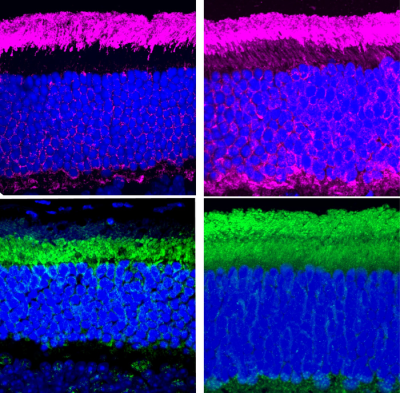
In eye tissue from an Usher syndrome mouse model (right), the light-dark cycle proteins (purple and green) are found spread throughout the two photoreceptor compartments rather than separated in one or the other as in the healthy mouse eye tissue (left). Image credit: eLife
Using data generated from patients and mice with genetic mutation for the disorder Usher syndrome, researchers from the University of Maryland School of Medicine (UMSOM), the National Institutes of Health’s National Eye Institute (NEI), and National Institute on Deafness and Other Communication Disorders (NIDCD), documented the natural history of vision impairment in patients and identified the cell mechanism behind progressive vision loss.
Based on these findings, published on November 9, 2021, in the journal eLife, the team was able to test a retinoid therapy that improved vision in mice with Usher syndrome. The researchers said assessing a similar therapy should now be considered in people with Usher syndrome to see if this therapy might slow vision loss.
First author of the study Saumil Sethna, Ph.D., Instructor in Otorhinolaryngology–Head & Neck Surgery, said, “There are currently FDA-approved relatives of these retinoid drugs that are available and have passed clinical trials for safety, along with others that are in phase II clinical trials to treat other types of vision loss disorders.”
The team hopes to partner with one of the companies testing these drugs to launch a clinical trial in patients with Usher syndrome type 1F to see if it can help by preventing continuing vision loss.